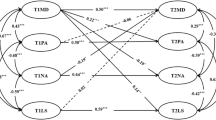Abstract
Researchers generally agree that Subjective Wellbeing (SWB) comprises both cognitive and affective components. However, the proportioning of their contributions, and the relationship between these constructs and personality, remain equivocal. This study investigated the relationship between these constructs, representing affect by Homeostatically Protected Mood (HPMood). Using a sample of 205 Victorian high-school students aged between 13 and 20 years, structural equation modeling determined that an HPMood-driven model of SWB was better fitting than either a personality-driven model of SWB or a cognition-driven model of SWB, explaining 80% of variance. These results support HPMood as the major component of SWB. They also reinforce the proposition that HPMood may be the driving force behind individual SWB set-points and the variable that SWB homeostasis seeks to defend.




Similar content being viewed by others
References
AMOS 7.0. (2006). Smallwaters Corp: Chicago, Il.
Blore, J.D., Stokes, M.A., Mellor, D., Firth, L., & Cummins, R.A. (2010). Comparing multiple discrepancies theory and affective models of subjective wellbeing. Social Indicators Research. doi: 10.1007/s11205-010-9599-2.
Campbell, A., Converse, P. E., & Rodgers, W. L. (1976). The quality of American life: Perceptions, evaluations and satisfactions. New York: Russell Sage Foundation.
Cohen, J., & Cohen, P. (1983). Applied multiple regression/correlation for the behavioural sciences (2nd ed.). Hillsdale, NJ: Erlbaum.
Costa, P. T., & McCrae, R. R. (1992). Revised NEO Personality Inventory (NEO-PI-R) and NEO Five-Factor Inventory (NEO-FFI) professional manual. Odessa, Florida: Psychological Assessment Resources.
Cummins, R. A. (1995). On the trail of the gold standard for subjective wellbeing. Social Indicators Research, 35, 179–200.
Cummins, R. A. (2010). Subjective wellbeing, homeostatically protected mood and depression: A synthesis. Journal of Happiness Studies, 11, 1–17.
Cummins, R. A., Collard, J., Woerner, J., Weinberg, M., Lorbergs, M., & Charini, P. (2010). Australian unity wellbeing index, survey 22: The wellbeing of Australians—who makes the decisions, health/wealth control, financial advice, and handedness. Melbourne: Australian Centre on Quality of Life, School of Psychology, Deakin University. Retrieved May 12, 2010, from http://www.deakin.edu.au/research/acqol/auwbi/survey-reports/survey-022-report-part-a.pdf.
Cummins, R.A., Lau, A.D.L. (2005). Personal Wellbeing Index—School Children (PWI-SC) (3rd ed.). Melbourne: Deakin University. Retrieved January 17, 2010, from http://www.deakin.edu.au/research/acqol/instruments/wellbeing_index.htm.
Cummins, R. A., & Nistico, H. (2002). Maintaining life satisfaction: The role of positive bias. Journal of Happiness Studies, 3, 37–69.
Davern, M., Cummins, R. A., & Stokes, M. (2007). Subjective wellbeing as an affective—cognitive construct. Journal of Happiness Studies, 8, 429–449.
DeNeve, K. M., & Cooper, H. (1998). The happy personality: A meta-analysis of 137 personality traits and subjective wellbeing. Psychological Bulletin, 124, 197–229.
Diener, E., & Diener, M. (1996). Most people are happy. Psychological Science, 7(3), 181–185.
Diener, E., Suh, E. M., Lucas, R. E., & Smith, H. L. (1999). Subjective wellbeing: three decades of progress. Psychological Bulletin, 125, 276–302.
Emmons, R. A., & Diener, E. (1985). Personality correlates of subjective wellbeing. Personality and Social Psychology Bulletin, 11(1), 89–97.
Gosling, S. D., Rentfrow, P. J., & Swann, W. B., Jr. (2003). A very brief measure of the Big-Five personality domains. Journal of Research in Personality, 37(6), 504–528.
Headey, B., & Wearing, A. (1989). Personality, life events, and subjective wellbeing: toward a dynamic equilibrium model. Journal of Personality and Social Psychology, 57(4), 731–739.
Headey, B., & Wearing, A. (1992). Understanding happiness: A theory of subjective wellbeing. Melbourne: Longman Cheshire.
International Wellbeing Group. (2006). Personal Wellbeing Index—Adult (PWI-A). Retrieved January 12, 2010, from http://www.deakin.edu.au/research/acqol/instruments/wellbeing_index.htm.
Kline, R. B. (1998). Principles and practice of structural equation modelling. New York: Guilford Press.
Loehlin, J. C. (1987, 1992). Latent variable models: An introduction to factor, path, and structural analysis (2nd ed.). Hillsdale, NJ: Lawrence Erlbaum.
Michalos, A. C. (1985). Multiple discrepancies theory (MDT). Social Indicators Research, 16, 347–413.
Pallant, J. (2001). SPSS Survival Manual. Sydney: Allen & Unwin.
Peterson, C. (2000). The future of optimism. American Psychologist, 55(1), 44–55.
Russell, J. A. (2003). Core affect and the psychological construction of emotion. Psychological Review, 1, 145.
Russell, J. A. (2009). Emotion, core affect, and psychological construction. Cognition & Emotion, 23(7), 1259–1283.
SPSS for Windows: Release 17.0. (2008). Chicago: SPSS Inc.
Steel, P., & Ones, D. S. (2002). Personality and Happiness: A national level analysis. Journal of Personality and Social Psychology, 83(3), 767–781.
Tabachnick, B. G., & Fidell, L. S. (2001). Using multivariate statistics (4th ed.). MA: Allyn & Bacon.
Thompson, B. (2004). Exploratory and confirmatory factor analysis: Understanding concepts and applications. Washington, DC: American Psychological Association.
Thompson, S. C., Thomas, C., Rickabaraugh, C. A., Tantamjarik, P., Otsuki, T., Pan, D., et al. (1998). Primary and secondary control over age-related changes in physical appearance. Journal of Personality, 66(4), 583–605.
Tomyn, A. J., & Cummins, R. A. (2010). The Subjective Wellbeing of High-school Students: Validating the Personal Wellbeing Index – School Children. Social Indicators Research. doi:10.1007/s11205-010-9668-6.
Veenhoven, R. (1994). Is happiness a trait’? Test of the theory that a better society does not make people any happier. Social Indicators Research, 32, 101–160.
Vitterso, J. (2001). Personality traits and subjective wellbeing: Emotional stability, not extraversion, is probably the important predictor. Personality and Individual Differences, 31(6), 903–914.
Vitterso, J., & Nilsen, F. (2002). The conceptual and relational structure of subjective wellbeing, neuroticism, and extraversion: once again, neuroticism is the important predictor of happiness. Social Indicators Research, 57, 89–118.
Author information
Authors and Affiliations
Corresponding author
Rights and permissions
About this article
Cite this article
Tomyn, A.J., Cummins, R.A. Subjective Wellbeing and Homeostatically Protected Mood: Theory Validation With Adolescents. J Happiness Stud 12, 897–914 (2011). https://doi.org/10.1007/s10902-010-9235-5
Published:
Issue Date:
DOI: https://doi.org/10.1007/s10902-010-9235-5




